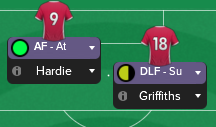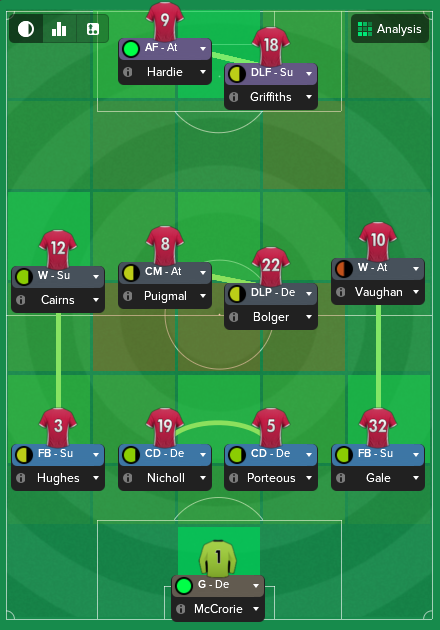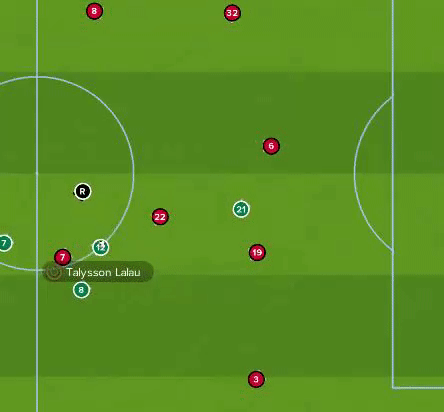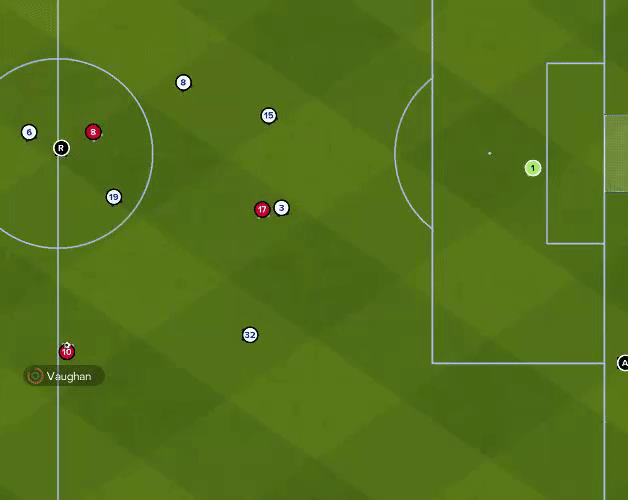With the treble treble secured last season (that's three consecutive seasons of the SPL, Scottish Cup and Scottish Supercup being won, all three available domestic trophies), it's safe to say we're dominating domestic football. Going in to each new season I'm confident we would consistently be able to do what was required to win the league title. I'm bias, but results do show we've got the strongest squad in the country, while the data shows that we're league leaders in determination and physical attributes, two areas I look to excel in and value above all else.
Would these facts see us go on to secure a quadruple treble?
Domestic Cups
We cruised past last season's league runners up, St Johnstone, in the Scottish Supercup season opener. That's our fourth consecutive win in that competition now after failing to win it in our first couple of appearances.
We then proceeded to cruise into our fifth consecutive Scottish Cup final, and seventh overall. Aberdeen looked our toughest test on paper in the 4th round, but Stirling youth product, Alex McGrandles, got us on our way to a comfortable 3-0 win with an own goal. Bigger Kawaya and European Golden Boy, Jack Beaton, demolished Queen of the South in the semi-final to set up a final clash with Hibs.
Who would win their first Scottish Cup since 2015/16. A really disappointing result, but at the end of the day we weren't good enough to win the game and didn't deserve to. Hibs had the better of the chances, with our only clear cut chance coming from Griffiths' missed penalty just before half time. If we'd scored that, I believe it would have put us in the driving seat, despite Hibs missing a penalty of their own at 1-1 earlier on in the first half. It looked as though Barkaia's goal and Sato's sending off for Hibs had swung the match in our favour going in to extra time, but Gary Shinnie got his second as we were restricted to long shots and kept at bay by the Hibees.
No domestic treble this season. No quadruple treble.
SPL
Hibs' Scottish Cup win wouldn't be a sign of things to come in the league too, would it?
There's plenty of green dots across the first half of the season, but the two results that really stick out are those two 3-2 defeats in a row on matchday three and four against Celtic (getting one over us for the first time in three seasons) and my boyhood club, Greenock Morton. No excuses for the defeats, it was our strongest eleven in both matches, we didn't do enough to win. We were especially second rate in the Morton defeat. Hibs were the other club to take points off us in the first half of the season, but our consistency across the other fourteen matchdays saw us topping the table at the halfway stage.
Morton! Wtf! It's really difficult to put personal feelings aside and be raging at my club for taking six points from us this season. It was 1-1 going into the last 10 minutes and I went for the win and pushed men forward. They hit us on the break and sent us back to Stirling with our tails between our legs. Hibs also inflicted a defeat on us to make it a miserable season against Paul Lambert's men. Celtic took another point off us too to go undefeated against us this season too. What was going on? Surely these dropped points wouldn't see us give up our grip on the SPL?
Nah, we still won it by 10 points in the end. But it was our worst season since 2025/26, the first SPL title winning season. It was the most we've conceded since that season, the least number of goals scored since that season and the four defeats is the most we've had in a season since the season prior to our league win, 2024/25. What happened?
As I mentioned in my transfers post, I felt it was time to blood more homegrown youngsters into the squad and I predominantly chose to do this in domestic matches. Shaun Greene aside, all of my young Scots played over 1,000 minutes this season across the league and Scottish Cup, with Hendry and Carr actually being my first choice CB pairing domestically. It was a conscious choice, but one that maybe led to performances not being as good as they could have been across each of the 34 matches.
The forward pairing of Sambu and Griffiths was fairly settled this season, but I heavily rotated the midfield four behind them. This was mainly due to me not really settling on what my strongest four was, but also because I'm a tinkerer. I want to give players gametime and also see how they'll do in match situations. Competing on multiple fronts, it's also necessary at times. I do tend to go on a bit more about the negatives, but the most important time to reflect and act is when you're on top.
Champions League
We did really well qualifying out of our group containing PSG and Chelsea last season in the CL, luck wasn't on our side in this season's competition though.
United's record against us now stands at played six, won six. I can't get the better of Mourinho. They knocked us out in the 1st knockout round last season and they've all but done it again this season, by drawing and losing against Atletico while we won and drew against the La Liga side. We could've made it a bit easier for ourselves too by beating CSKA at home, but had to play the majority of the match with 10 men after Daniel Christensen was sent off early in the first half.
That 3rd place finish means we drop into the Europa League for the first time since 2025/26. We reached the semi final that season, could we go one better this time?
Europa League
We dealt with a long away trip to Russia rather well in the 1st knockout round, dismantling Krasnodar 5-0 before hitting six past them in the home leg to sail through to face Athletic Club. After scoring six again in the home leg I felt confident, but those three we conceded set up a really nervy second leg in Spain and we only just made it through by the skin of our teeth in the end. The Basque club battered us in Bilbao, but couldn't convert their chances into shots on target or goals.
We'd already faced my former FM17 club, RBLeipzig, back in that 2025/26 Europa League campaign, eventually going through on away goals after another nervy 2nd leg. This time round it was a little bit more comfortable, a 4-1 aggregate victory. I was happy to avoid Spurs and Crystal Palace in the semi final draw, English clubs are always tough to play against, especially with the 14 seasons of financial power behind them now. Braga gained control of the tie in the 1st leg, but we'd played well enough without creating many opportunities to score an away goal. When the Big Man Kawaya scored before half time in the 2nd leg I didn't think it would take until the 119th minute of the match to secure the win and take us through to the Europa League final, but it was fist pumps all round when it did eventually come!
Crystal Palace overcame Spurs in the other semi to set up what I dubbed on Twitter as the worst Europa League final ever.
An uninspiring effort going forward but a solid one at the back brought home the Europa League trophy for little old Stirling Albion! From the 3rd tier of Scottish football when I took over to Europa League winners in 14 seasons, I don't think that's too bad at all. Past winners of the trophy over the last 14 seasons include Real Madrid, Man City, Arsenal, Dortmund and Liverpool. Stirling Albion is now engraved on the trophy too. Here's that winning goal from Daniel Christensen, who joined us on a free transfer four seasons ago, not bad value.
He intercepts a loose ball on the edge of our own penalty area and runs the length of the pitch to eventually get on the end of Griffiths' cross in the opposition six yard box to bring the trophy to Stirling.
Star men
Ença Sambú
The main man across the season was Sambuuu. He'd scored 26 goals in each of the last three seasons, but he really benefited from there not being as much rotation up front this season as he fired in 39 goals across all competitions. This included seven in Europe, as he managed to win the Europa League Player of the Season. He set a new record in the SPL too, scoring 30 goals in 32 appearances, earning him the Players' Player of the Year and Football Writers Player of the Year awards. As a reminder, he joined for £425k from Guimarães. Not bad value at all across the four seasons he's been at the club.
Gogita Barkaia
This was the breakout season for Barkaia playing in the CM(A) position. He's ridiculously gifted, a wonderkid, and could be the Horvat replacement we've been waiting for for a couple of seasons now. His output wasn't incredible, five assists and seven goals, but the importance of that role on the pitch for us is much more than pure goals and assists. So often the hockey pass or just keeping things ticking over. A product of that Circle of Transfers approach and how good our scouting set up is, just a £450k signing from Lokomotivi Tbilisi last season, he's had to bide his time before cementing down his starting spot.
Club growth
Thanks to some positive overall performances in Europe for our clubs over the last couple of seasons, culminating in our Europa League win, Scotland has moved up to 7th in the Nation Club Coefficients table. It's still a long way to go to overhaul Germany and reach that coveted 6th spot which would bring two automatic Champions League group stage spots and a third spot in the qualifiers for the league. That being said, in the fourteen seasons I've been charge, Scotland has come a long way from the 23rd spot it was languishing in back in 2017/18.
Stirling wasn't even on the map in terms of European football when I took over, but now we're Europa League winners and up to 15th in the club coefficient table. Not a bad rise at all. There's still a long way to go with our continental reputation though. We still can't compete with the likes of United, Barcelona, Real Madrid or PSG. We're also still behind clubs we've competed well with in recent seasons, Atletico Madrid, Chelsea, Athletic Club and even Crystal Palace. We've made huge progress, but there's still a way to go yet.
There was just over £150k in the club balance when I took over, that now stands at over £320m with player sales totaling £119m this season. Here's the usual line graph for season ticket holders and league average attendance.
Some really promising numbers versus the 2029/30 season. Season ticket sales were up 24% to 8,760 overall. This is a whopping 3404% increase versus my first season in charge. Our league average attendance grew by 19% which meant it has grown 2852% since the 2017/18 season. Both of these, along with gate receipts growing 8391%, have been huge parts of the save in line with growing the club as a whole. Moving from Forthbank to the Samo Stadium, and then expanding the capacity on two separate occasions, has enabled the club to become the most well run and reputable in the country.
The Europa League win feels like an appropriate time to end the save ahead of FM19 coming very soon. What a save it's been. FM is telling me it's been a while since I've had any human contact after putting in over 37 days of gametime into this save. I'll be summarising it all in my usual post of the game that I've done for the past two editions now, plus I quite fancied putting together a best XI type post, but we'll see what happens over the next few weeks.
I say it's coming to an end, I can't bring myself to take an FM break like others do. What else would I do with my spare time? Probably make human contact but that's beside the point. I'm going to be "moving upstairs" for season fifteen, and act as a Director of Football/Sporting Director. My assistant for the last five seasons, the great Walter Samuel, is going to "take over" as Head Coach. I'll still be in charge of my favourite things to do in-game, building the squad, buying and selling players. Walter is going to be setting the tactic (I'll shift the 4-4-2 to his preferred 4-2-3-1), picking the team and managing the matches (I'll be instant resulting). Something a little bit different to how the save has gone so far, and a little bit different to the norm too.





































